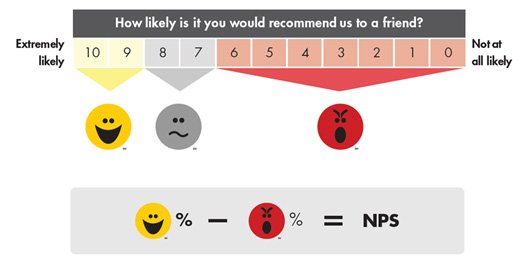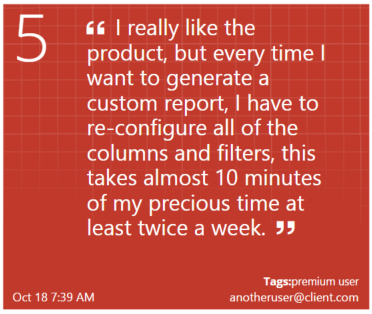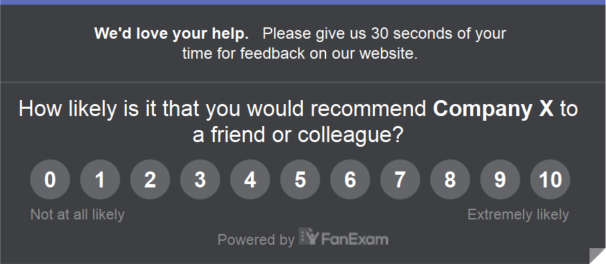
When Neo took the red pill he forgave the “ignorance of illusion” of the fabricated reality of the Matrix in favor of “truth of reality” — even though it was a harsher, more difficult life. This is exactly how I feel towards SaaS companies that have embraced the Net Promoter Scoresm (NPS®) – they really want to grow by diving into the customer experience and grasping the true feelings of their clients.
You are probably thinking that you already measure customer sentiment: “but I already have Google Analytics installed on my site – I already know my customer behavior.” Ok – that’s the blue pill, ESP, denial, whatever you wanna call it. You should be thinking: “we consistently use a formal process for measuring customers satisfaction & loyalty”.
Why NPS: Simple, Proven Framework
The Net Promoter System® is a proven method used to gain insight into customer loyalty (behavior and sentiment) of brands and products and is trusted by the world’s most respected companies (Apple, Amazon, Harley-Davidson, etc). With just one question (and an open-ended follow-up question used to identify root-causes), you can truly grasp customer satisfaction for your product/service:

The would recommend question is far and away the best single-question predictor of customer behavior across a range of industries – and not just referrals but repeat and expanded purchases, along with willingness to provide constructive feedback. Supported by hundreds of cases and tons of research, the NPS is becoming the standard management tool to gauge the loyalty of a firm’s customer relationships.
For more information about the NPS, please visit: netpromotersystem.com.
7 Reasons your SaaS should start using NPS today
Is the customer sentiment towards your product positive – or are clients simply using it because there is no alternative?
Although NPS was originally created before the existence of SaaS products, it’s a perfect fit for this type of offering. Below I listed the principal benefits of using NPS as your customer satisfaction gauge for your SaaS product:
Reduce churn – Identify & reach out to your detractors
Detractors are unsatisfied with your product and will probably cancel their service or never purchase again. Kill churn by learning who these customers are, and engaging with them before they leave.
Takeaway: Apple calculated that every hour spent on the phone with detractors ($29/hr)1 was generating more than $1,0002 in revenue in the first year.
Product Manager’s Dream: Validate pipeline priority
Just launched a major update or a brand new shining feature? Besides the behavior metrics – are customers actually happier with the update?

that can be used by Product Manager.
Use real customer ratings & feedback to define the product road-map. Set priorities that can convert detractors and passives into promoters. Dig into what really makes your customers become fans and surface these benefits even more.
Remember that human beings are emotional creatures, and that the user experience with your SaaS product is a relationship. Satisfaction does not necessarily translate to more or better features (remember Yo?) and that in the long term, we all should always focus on increasing customer happiness.
Takeaway: Perception is reality (Matrix again!). After facing troubling customer-relations issue: an inordinate number of complaints about the long waits at baggage claims – Houston Airport invested in many costly solutions. Results were dismal & expensive – until testing a new approach: instead of reducing wait times, it moved the arrival gates away from the main terminal and routed bags to the outermost carousel. Passengers now had to walk six times longer to get their bags. Complaints dropped to near zero.3 (NYTimes Article)
Explain the true value of your SaaS to investors
Consistently measuring your customer satisfaction using a well-established, recognized tool allows potential acquirers and investors to quickly gauge how satisfied your customers are relative to those of other companies they have invested in. Many private equity firms & venture capitalists will insist on performing a Net Promoter Score survey with your customers before they invest in your business.
Another benefit for investor relations is that maybe your growth is just not there yet, traction is taking longer to arrive. If you have a good NPS score (above 50), and this metric keeps moving up with the evolution of your product, you have a great ally in the metrics division for product/market fit validation.
Takeaway: Sequoia Capital, founded in 1972, is a leader in the venture capital business that really understands SaaS. Sequoia has backed startups that now command a staggering $1.4 trillion of combined stock market value, equivalent to 22% of Nasdaq. Practically all of their investments gauge customer satisfaction with NPS4.
Market your offering as consumers actually perceive it
The adage goes: it’s not what you say, it’s how others hear you. Learn from the open responses how the people who are paying you money are defining your features and benefits to create better targeted communications to your prospects. Nothing better than the actual, natural language of your clients to define what you are really selling.
Takeaway: Testimonials are invaluable in generating social proof and validating customer success stories with your offering. Use your promoters’ open feedback as testimonials!
You can start doing it right now (cheap & easy)

You can deploy the questionnaire in minutes and enjoy a very high response rate because answering it is not a burden on respondents. Although it appears easy to prepare a email blast asking your customers their rating do consider surveying your customers directly in your SaaS interface. Besides guaranteeing a much higher response rate, you will gauge their actual sentiment while they are using their service, and not days or weeks later while they are checking email at Starbucks ordering a cappuccino.
Takeaway: FanExam is 100% FREE and takes less than 5 minutes to install on your SaaS product / website.
Going viral – you need your promoters!
Looking for the hockey-stick growth curve? Discover who your promoters are and tap into their enthusiasm to get the word out. 92% of people trust recommendations from friends and family more than all other forms of marketing.5 Sincerely, think to yourself for 10 seconds: what are you really doing to leverage your SaaS offering with your biggest fans?
Takeaway: Once you’ve identified your promoters, reach out to them and ask each each one of them for an intro to a fellow client they think you should reach out with and present your service to.
Learn where you stand, compare your score to other SaaS offerings
Maybe you are the market leader in a SaaS category – or the newcomer, or maybe the only player. You probably already compare your bounce rate, conversion rate, MRR and dozes of other metrics to competitors and other SaaS products. What about customer satisfaction? Imagine if everyone measured NPS and published their score. We would have a transparent yardstick to compare how happy clients are across the board.
Takeaway: Be transparent about your score, even if it isn’t in the top percentile. Remember that specific industries and solutions may naturally have a lower average score than others6. The important lesson here is measure and react to your customer feedback, and this will inevitable increase your NPS.
“But I already measure customer satisfaction”
I’ve heard dozens of SaaS entrepreneurs mentioning that they already measure customer satisfaction. when they are not using NPS, all I see are copper-tops stuck in the Matrix. Below are some of the excuses I hear and why I believe they are simple evasions of true growth:
- I have Google Analytics, and I know my customers’ satisfaction levels based on their behavior. This entire post is dedicated in showing that behavior metrics are hard to translate into satisfaction levels. It’s like measuring the temperature with a barometer, there may be a correlation, but not a correct measure. But bringing in NPS data into Google Analytics can surface some golden nuggets insights, read more about our integration here.
- I already measure customer feedback through my support system. Support is reactive, don’t wait for someone to come and tell you something is wrong. Also, just because people don’t complain, that doesn’t necessarily mean it’s working well.
- I already use surveys to get customer satisfaction levels. What’s your response rate? Less than 5%? Low response rates almost always result in volatile and unreliable scores. Who created the questions? With what frequency are you surveying your customers? Are you using a reliable framework? Why not rely on decades of study and best-practices by market leaders? If you use email, don’t forget that besides the fact that open rates are declining rapidly, your clients are probably on their smartphone busy thinking of something else when they answer your survey. This feedback is impacted by their current state of being and probably will not correctly gauge their true satisfaction levels while actually using your product.
- I don’t want to annoy my users with inquiries, surveys and feedback requests. Maybe they are already annoyed enough with your SaaS. Harsh, sorry, but maybe true. Your clients may be upset and wanting to give feedback, but are just too busy to stop what they are doing to open a new support ticket or send you an email. By implementing a 30-second survey directly in your SaaS product (you know your SaaS – and I’m sure you can find a way to survey your customers in a way to collect responses), you will gain access to tons of valuable insights.
Start measuring NPS now

So what are you waiting for?
Do you really want to get close to your customers? Until we can get a direct connection to our customers’ minds, we need frameworks like the NPS to get as close as possible. Check out FanExam for a sweet solution.
Footnotes:
- http://pando.com/2013/10/21/apple-bends-over-backwards-to-make-customers-happy-but-is-it-a-waste-of-time-and-money/
- The Ultimate Question, Kindle location 218
- https://www.nytimes.com/2012/08/19/opinion/sunday/why-waiting-in-line-is-torture.html?pagewanted=all
- http://www.forbes.com/sites/georgeanders/2014/03/26/inside-sequoia-capital-silicon-valleys-innovation-factory/
- http://www.nielsen.com/us/en/insights/reports/2012/global-trust-in-advertising-and-brand-messages.html
- http://cdn2.hubspot.net/hub/268441/file-1361232783-pdf/Benchmarks_PDFs/Satmetrix_2014_B2C_Benchmark_Overview.pdf

